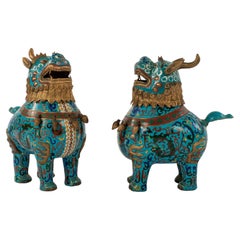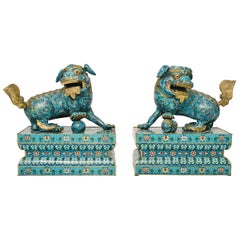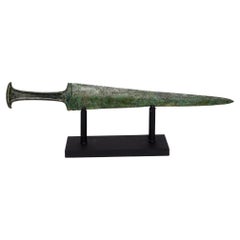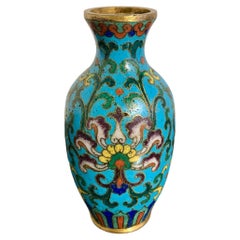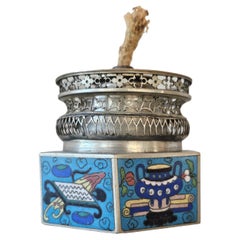Texas - Metalwork
to
1
91
1,053
607
90
1
2
1
28
24
38
1
28
6
1
8
2
2
4
89
48
19
19
18
85
72
35
30
8
91
90
90
2
1
1
1
Item Ships From: Texas
Pair Chinese Cloisonné Fu Dogs
Located in Houston, TX
Copper base cloisonné Fu Dogs made for Chinese export with gilded, mane, ears and accents. This pair from 1910s or earlier.
Category
Early 1900s Chinese Chinese Export Antique Texas - Metalwork
Materials
Copper
$5,800 / set
19th Century Chinese Cloisonné Fu Dogs
Located in Houston, TX
An exceptional palatial quality pair of 19th century Chinese cloisonné Fu dogs featuring gold gilding over copper.
Chinese cloisonné o...
Category
1890s Chinese Chinese Export Antique Texas - Metalwork
Materials
Copper, Enamel
$85,000 / set
Antique Indian Dhokra Horse and Rider Sculpture
Located in Dallas, TX
Presenting a lovely antique Indian Dhokra horse and rider sculpture.
Probably from the late 19th or early 20th century as is evidenced by its natural patina and clear evidence of age.
It depicts an Indian Warrior with a sword in his right hand mounted on his horse/steed.
The warrior is in classical and ancient Southeast Asian Indian attire and he holds the horse’s reins in his left hand.
The body of the horse is a series of lines (in the Classic Dhokra Style) and it has a tribal headdress...
Category
Late 19th Century Indian Anglo Raj Antique Texas - Metalwork
Materials
Metal
Western Asiatc Luristan Bronze Dagger
Located in Dallas, TX
2000-700 BC. Luristan (Louiristan) Culture. Bronze dagger with a bevelled leaf-shaped blade and wrap-around handle culminating in an oval-shaped pommel. The handle would originally h...
Category
15th Century and Earlier Persian Archaistic Antique Texas - Metalwork
Materials
Iron
Chinese Cloisonne Incense Tool Vase, Qing Dynasty, 18th/19th Century, China
Located in Austin, TX
A small and elegant Chinese cloisonné vase for incense tools, Qing Dynasty, 18th/19th century, China.
Made for the scholar's studio, this small refined vase, was used to hold incense tools, including a small pair of tongs or chopsticks and spoon. The tools no longer present.
Of miniature baluster vase form, the vase beautify proportioned and decorated in the cloisonné enamel technique, with gilt wires forming the cloisons, or partitions. Within the cloisons, colorful enamels have been expertly laid.
The small incense tool vase...
Category
Early 1800s Chinese Qing Antique Texas - Metalwork
Materials
Copper, Enamel
Antique Chinese Cloisonne Enamel Opium Oil Lamp
Located in Forney, TX
A rare and a bit unusual Qing Dynasty (1636-1912) cloisonne enameled opium lamp. Originating in China in the 19th century, the silver-tone oil lamp features a six sided base with uni...
Category
19th Century Chinese Qing Antique Texas - Metalwork
Materials
Metal, Enamel
Dong Son Culture Ritual Bronze Drum, 4th-3rd Century BC, Vietnam
Located in Austin, TX
A well cast and intricately decorated bronze drum from the Dong Son culture, circa 4th - 3rd century BC, Red River Delta, Vietnam.
The face of the drum features a central 8 pointed...
Category
15th Century and Earlier Vietnamese Antique Texas - Metalwork
Materials
Bronze
Chinese Western Han Dynasty Bronze Garlic Head Vase, 206 BC - 25 AD
Located in Austin, TX
A rare and attractive Chinese bronze "garlic head" vase with an encrusted patina, Western Han Dynasty, 206 BC - 25 AD, China.
Of classic form, the bronze vase is set on a short, s...
Category
15th Century and Earlier Chinese Han Antique Texas - Metalwork
Materials
Bronze
Chinese Lao Tian Li Cloisonne Cylindrical Box, Late Qing Dynasty, China
Located in Austin, TX
A delightful antique Chinese cloisonné cylindrical box and cover by Lao Tian Li, late Qing Dynasty, circa 1900, China.
The box of cylindrical form and w...
Category
Early 1900s Chinese Qing Antique Texas - Metalwork
Materials
Brass, Copper, Enamel
Japanese Cloisonne Box by Inaba, Meiji Period, circa 1900, Japan
By Inaba Cloisonne Co.
Located in Austin, TX
A fine Japanese cloisonne hinged box with pheasant and autumn foliage, by Inaba Nanaho and the Inaba Cloisonne Company, Meiji period, circa 1900, ...
Category
Early 1900s Japanese Meiji Antique Texas - Metalwork
Materials
Copper, Enamel, Metal
Chinese Cloisonne Incense Burner, circa 1960's, China
Located in Austin, TX
A fine and beautifully enameled Chinese cloisonne incense burner, censer, with pierced cover, mid 20th century, circa 1960's, China.
The ce...
Category
1960s Chinese Qing Vintage Texas - Metalwork
Materials
Copper, Enamel
Chinese Ming Dynasty Silver Nine Phoenix Coronet Crown, 16th/17th Century
Located in Austin, TX
An amazing and rare Chinese silver Nine Phoenix Coronet or Crown, Ming Dynasty (1368 to 1644), late 16th to early 17th century, China.
A delicate and...
Category
Early 17th Century Chinese Antique Texas - Metalwork
Materials
Silver, Gold
Chinese Archaisit Cast Bronze Ding Tripod Censer, Early 20th Century, China
Located in Austin, TX
A well cast Chinese archaistic bronze tripod censer, ding, in the Ming style, Republic Period, early 20th century, China.
Heavily cast in the arc...
Category
Early 20th Century Chinese Archaistic Texas - Metalwork
Materials
Bronze
Archaic Chinese Bronze Ritual Vessel, Gui, Early Western Zhou, 11th century BCE
Located in Austin, TX
A stunning and rare Chinese archaic bronze gui, a type of ritual bronze vessel used to hold grain, either for feasting, or for making offerings ...
Category
15th Century and Earlier Chinese Archaistic Antique Texas - Metalwork
Materials
Bronze
Pair 18th/19th Century Chinese Bronze Elephant Figure Candle Holder Sculptures
Located in Forney, TX
A pair of finely cast and incised burnished bronze candlestick elephants, Chinese school, 18th-19th Century, Qing Dynasty (1636-1912).
Each elephant is standing foursquare with head...
Category
Early 19th Century Chinese Qing Antique Texas - Metalwork
Materials
Bronze
Early 20th Century Gilt Metal Thai Khon Dancer
Located in Dallas, TX
Presenting a beautiful early 20th century Gilt Metal Thai Khon Dancer.
Made in Thailand (South East Asia) circa 1920.
It features a gilt meta...
Category
Early 20th Century Thai Country Texas - Metalwork
Materials
Metal
Japanese Meiji Champleve and Bronze Urn
Located in Dallas, TX
Presenting a gorgeous Japanese Meiji Champleve and bronze urn.
Made in Japan during the Meiji Period circa 1880.
The body of ...
Category
Late 19th Century Japanese Meiji Antique Texas - Metalwork
Materials
Bronze, Enamel
Antique Chinese Qing Cloisonné Enamel Bronze Censer Vase in Dragon Turtle Figure
Located in Forney, TX
PATINATED GILT-BRONZE AND CLOISONNÉ ENAMEL ‘BIXI AND GU’ CENSER / VASE, QING DYNASTY, CHINA, CIRCA 1850 OR EARLIER
A magnificent, very high-quality, incredibly colored 19th century...
Category
19th Century Chinese Qing Antique Texas - Metalwork
Materials
Bronze, Enamel
Pair Japanese Bronze Pagoda Temple Lanterns, Taisho Period, circa 1920, Japan
Located in Austin, TX
An elegant pair of Japanese cast and lacquered bronze pagoda lanterns, Taisho Period, circa 1920, Japan.
The lanterns a true pair, with mirrored decorations and lantern doors opening in opposite directions. The lanterns of traditional toro form, cast in bronze, and lacquered. Each lantern comprised of three parts - the "roof", the "fire box", and the pedestal. This type of pedestal lantern is called a dai-doro, as opposed to the hanging lantern type, tsuri-doro.
The hexagonal roof of the lantern, reminiscent of temples or pagodas, features a wonderful, dense cloud pattern with three heart-shaped cutouts, known as inome, or boar's eye. The roof topped by a hoju, the Buddhist flaming Jewel of Wisdom. Each of the six corners feature a fantastic shachihoko, mythical beasts with the face of a tiger and body of a fish. Bells are suspended from the shachihoko.
The globular body of the lantern features four pierced panels with the three leaf hollyhock mon of the Tokugawa clan surrounded by a karakusa pattern of scrolling vines. One panel serving as a hinged door with a lock stylized as the Three Jewels...
Category
1920s Japanese Taisho Vintage Texas - Metalwork
Materials
Bronze
Japanese Bronze Usubata with Waves and Plovers, Edo Period, Mid-19th Century
Located in Austin, TX
An impressive Japanese cast bronze usubata, vessel for ikebana, in the form of a large conical vessel being supported by crashing waves and flying chidori. Edo Period, mid-19th centu...
Category
Mid-19th Century Japanese Edo Antique Texas - Metalwork
Materials
Bronze
Chinese Archaic Patinated Bronze Vase, Early 20th Century
Located in Austin, TX
An elegant and beautifully cast early 20th century Chinese bronze vase in the archaic style with a gorgeous lacquer simulated patina in shades of brown, red and green.
The shoulders...
Category
Early 20th Century Chinese Archaistic Texas - Metalwork
Materials
Bronze
Khmer Bronze Two Part Bottle Vase, Angkor Period, 12th-14th Century
Located in Austin, TX
An elegant Khmer pear shaped bronze bottle vase, Angkor Period, 12th-14th century.
Crafted of bronze in two parts. When separated, the lower portion of the vase becomes an offerin...
Category
15th Century and Earlier Cambodian Antique Texas - Metalwork
Materials
Bronze
Large Dong Son Culture Ritual Bronze Bell
Located in Austin, TX
A large and finely cast ritual bronze bell from the Dong Son Culture (circa 1000 BC-200 AD).
Of unusually large size, the thinness of the bronze speaks to the advanced techniques ...
Category
15th Century and Earlier Vietnamese Antique Texas - Metalwork
Materials
Bronze
Harmony in Enamel and Silk: Pair of Cloisonne' Lamps with Silk Lampshades
Located in Austin, TX
These cloisonné lamps stand as a testament to timeless craftsmanship. Each lamp is a symphony of artistry, meticulously crafted by skilled hands.
The deep blue cloisonné base serves...
Category
20th Century Chinese Texas - Metalwork
Materials
Metal
Vintage Yogya Silver Kala Bowl by Tom's Silver, circa 1960's, Indonesia
Located in Austin, TX
A bold and well crafted Indonesian Yogya (Jogja, Djokja) silver bowl by Tom's Silver, Yogyakarta, Java, Indonesia, circa 1960's.
The elegant bowl features a striking design of a Kala face, a protective monster often found above temple doors, and representative of time, death, and rebirth. A pair of makara flank the wide open, smiling mouth. A stylized foliate design surrounds the Kala.
Kala are analogous with the Kirtimukha, or face of glory, originating in India and associated with Shiva. Both beings are devourers of evil and tasked with protection
The bowl features two beaded borders, and a scalloped rim.
The bowl set on three short out-swept feet.
Stamped mark to the underside reading "TOM" "800" "DELUX". TOM stands for Tom's Silver, perhaps the most famous silver workshop in Yogyakarta. 800 is the purity of the silver (80%). DELUX is a common mark on Yogya silver...
Category
1960s Javanese Vintage Texas - Metalwork
Materials
Silver
Massive Japanese Meiji Period Bronze Vase, Late 19th Century, Japan
Located in Austin, TX
A very large Meiji period bronze vase, possibly for temple use, with high relief design and elephant head handles, late 19th century, Japan.
Of baluster form and unusual size, yet ...
Category
Late 19th Century Japanese Meiji Antique Texas - Metalwork
Materials
Bronze
Large Himalayan Inlaid Bronze Vajra with Wrathful Faces, 15th-16th Century
Located in Austin, TX
A large and unusual Himalayan bronze and mixed metal nine prong vajra featuring wrathful faces. In the style of the Tangut (Western Xia) Kingdom (1038 to 1227), but probably later, most likely 15th-16th century.
The body of the vajra crafted from a copper alloy, with five wrathful faces on either side and gold and silver inlays to the center. The prongs crafted of iron, with each side having eight prongs arcing outwards around a central prong before coming back to a copper alloy point.
The vajra is meditational tool...
Category
16th Century Mongolian Antique Texas - Metalwork
Materials
Iron, Gold, Silver, Bronze
Large Japanese Bronze Koro Incense Burner, Meiji Period, 19th Century, Japan
Located in Austin, TX
A large and fantastic Japanese cast bronze incense burner, koro, with high relief design, Meiji period, late 19th century, Japan.
The large and tall koro cast in extremely high re...
Category
Late 19th Century Japanese Meiji Antique Texas - Metalwork
Materials
Bronze
Pair of Korean Goryeo Dynasty Bronze Pedestal Bowls, 13th-15th Century, Korea
Located in Austin, TX
An exquisite pair of Korean bronze pedestal offering bowls, Goryeo Dynasty, 13th-15th century, Korea.
The Goryeo bronze bowls of generous proportions, with high sides and an ever so slightly everted rim. The bowls are supported on a pedestal base with a tall stem and wide, splayed ring foot.
The bowls plain, save for a single engraved line circumscribing the splayed foot.
The bowls with an amazingly rich and complex patina of mottled reddish browns from cuprite and dark greens from malachite. The bronze heavily cleaned to the European taste, removing most of the encrustations. Some areas of the bowls with rougher areas where the accretions could not be removed.
Crafted in two parts in the spun bronze technique, then joined. The bowls are unusually thin for bronze, with the lathe lines still visible to the undersides.
An unusual form and size for Goryeo period bronze utensils...
Category
15th Century and Earlier Korean Antique Texas - Metalwork
Materials
Bronze
Chinese Bronze Dragon Vase with Arrow Handles, Qing Dynasty, 18th Century, China
Located in Austin, TX
A well cast and powerful Chinese dragon bronze altar vase with arrow handles, Qing Dynasty, 18th century or earlier, China.
The altar vase of bottle form, set on a high, splayed r...
Category
18th Century Chinese Qing Antique Texas - Metalwork
Materials
Bronze
19th Century Japanese Meiji Era Patinated Bronze Foo Dog Lion Group Censer
Located in Forney, TX
A large and impressive Japanese Meiji period (1852-1912) patinated bronze guardian lion censer.
Late 19th century, Japan, exceptionally executed, the group consisting of four shishi...
Category
Late 19th Century Japanese Meiji Antique Texas - Metalwork
Materials
Bronze
Antique Japanese Patinated Bronze Buddhistic Lion Censer 17th/18th Century
Located in Forney, TX
A remarkable Edo Period (1603-1868) Japanese patinated bronze Buddhistic lion censer, exceptionally executed sculptural shishi foo dog form, finely detailed, retaining the original r...
Category
18th Century Japanese Edo Antique Texas - Metalwork
Materials
Bronze
Japanese Miyao Style Gilt Bronze Samurai Archer, Meiji Period, Japan
By Eisuke Miyao 1
Located in Austin, TX
A spectacular Japanese cast, carved, and parcel gilt bronze sculpture, okimono, of a kneeling samurai archer, signed Kiyotsugu (died 1894), Meiji ...
Category
Late 19th Century Japanese Meiji Antique Texas - Metalwork
Materials
Bronze
Japanese Bronze Flower Vase, Edo to Meiji Period, circa 1860, Japan
Located in Austin, TX
A striking Japanese cast and carved patinated bronze trumpet mouth vase for flower displays, Edo to Meiji Period, mid 19th century, circa 1860, Japan.
The tall and elegant bronze fl...
Category
Mid-19th Century Japanese Edo Antique Texas - Metalwork
Materials
Bronze
Tall Antique Korean "Longevity" Brass Candlestick, circa 1900
Located in Austin, TX
A tall and elegant antique Korean candlestick, circa 1900.
The body crafted in two parts, and featuring circular brass reflector with a charming design of butterflies and magnolia...
Category
Early 20th Century Korean Texas - Metalwork
Materials
Brass
Peranakan Chinese Export Silver Tankard with Dragon Handle, 19th Century
Located in Austin, TX
A heavy and well cast Chinese export silver tankard with a dragon handle, made of the Southeast Asian market, mid-late 19th century, China.
The double walled mug or tankard featur...
Category
Late 19th Century Chinese Chinese Export Antique Texas - Metalwork
Materials
Silver
Japanese Silver Incense Burner, Akoda Koro, by Nomura, Meiji Period, Japan
Located in Austin, TX
A lovely and luxurious Japanese silver incense burner of lobed melon form, akoda koro, marked jungin and signed Nomura, Meiji Period, circa 1900, Japan.
The silver koro...
Category
1910s Japanese Meiji Vintage Texas - Metalwork
Materials
Silver, Sterling Silver
Chinese Canton Enamel Round Stacking Boxes and Cover, circa 1900, China
Located in Austin, TX
An absolutely lovely Chinese export pink Canton enamel round stacking box and cover, late Qing Dynasty, circa 1900, China.
The circular stacking box consists of a bowl form base, ...
Category
Early 1900s Chinese Qing Antique Texas - Metalwork
Materials
Copper, Enamel
Japanese Mixed Metal Okimono of Doves by Seifu, Meiji Period, Late 19th Century
Located in Austin, TX
A wonderfully naturalistic large Japanese Meiji period mixed metal okimono (ornamental sculpture) of a pair of oriental turtle doves ...
Category
Late 19th Century Japanese Meiji Antique Texas - Metalwork
Materials
Bronze, Silver, Copper
Japanese Meiji Period Sterling Silver 2 Handled Basket by Katsu Miyamoto
By Miyamoto Shoko 1
Located in Dallas, TX
PRESENTING a GORGEOUS, VERY HIGH QUALITY and EXTREMELY RARE piece of Japanese Meiji Period Sterling Silver 2 Handled Basket by Katsu Miyamoto.
EXQUISITE, EXCEPTIONAL, RARE & IMPORTANT!
This is definitely a Meiji Period piece due to the fact that it is marked with the sterling silver mark “jungin”.
The Meiji period was from 1868 to 1912 and in 1928 a law was introduced in Japan compelling the use of decimal marks for silver.
This pre-dates that decimalization law.
We are of the opinion that it is from circa 1900.
Miyamoto Shoko was founded in 1880 as the first silverware specialty shop. In 1899, Miyamoto Shoko’s silverwares were ordered by the family members of the Emperor of Japan, and to this day, they are making fine and graceful handicrafts with skillful craftsmen.
Loved by numerous customers since the Meiji era, Miyamoto Shoko’s products have also been given to Princess Mako and Princess Kako of Akishino, as well as Princess Aiko Toshinomiya, on their birthdays.
Katsu Miyamoto (宮本勝), in 1880, in order to increase the sales of tobacco and cigarettes to foreigners founded the Moyamoto Shoko company, which produced different silverwares in general and particularly silver cigarette cases. Miyamoto’s first name, Katsu (勝) in some sources is written as “Masaru”, since 勝 kanji can be pronounced in both ways.
This basket is of the HIGHEST QUALITY imaginable!
The top of the basket has the MOST GORGEOUS repousse work of flowers, probably lotus flowers, with leaves and foliage. It has an underlying chevron effect chasing, reflecting parquetry.
The 2 handles are cast in the form of bamboo handles.
The rim of the top likewise is cast as bamboo.
The base is equally stunning in a different way!
It is chased with a chevron effect, like parquetry flooring and the four feet simulate pieces of sliced bamboo with an interlinking gallery of support columns, likewise, simulating bamboo.
The QUALITY of WORKMANSHIP is OUTSTANDING!
The pieces weighs exactly 525 grams.
This piece takes my breath away!
This is one for the SERIOUS COLLECTOR of EXQUISITE AND RARE Japanese silver. You will not find another like it, for sale ANYWHERE ELSE IN THE WORLD …… I know as I have searched!
Provenance: Acquired from a Dallas Private Collector.
Dimensions: 9.6 inches wide, 7.6 inches deep and 2.75 inches tall ( 7.25 inches tall with handles up)
Condition: Very good. It looks like the base 4 legged gallery, has been repaired/re-attached to the base, but otherwise it is excellent and of Museum quality.
The Meiji period (明治時代 Meiji-jidai?), also known as the Meiji era, is a Japanese era which extended from October 23, 1868 through July 30, 1912.[1] This period represents the first half of the Empire of Japan during which Japanese society moved from being an isolated feudal society to its modern form. Fundamental changes affected its social structure, internal politics, economy, military, and foreign relations. The period corresponded with the reign of Emperor Meiji after 1868, and lasted until his death in 1912. It was succeeded by the Taishō period upon the accession of Emperor Taishō to the throne.
Solid silver pieces...
Category
Early 20th Century Japanese Meiji Texas - Metalwork
Materials
Sterling Silver
Pair Japanese Cloisonne Dragon and Phoenix Jardinieres, Meiji Period
Located in Austin, TX
A lovely pair of Japanese chakinseki, tea dust, cloisonne jardinieres, Meiji Period, circa 1900, Japan.
The jardinieres each with a squat globular body, short neck, and wide, everted mouth. The bodies decorated wide lappets of mottled puce featuring alternating dragons and phoenixes...
Category
Early 1900s Japanese Meiji Antique Texas - Metalwork
Materials
Copper, Enamel
Chinese Export Silver Dragon Spoon by Wang Hing & Co., Late 19th Century
By Wang Hing & Co.
Located in Austin, TX
A very fine and charming Chinese export silver spoon in the form of a dragon, by Wang Hing & Co., Qing Dynasty, late 19th century, China.
...
Category
1890s Chinese Chinese Export Antique Texas - Metalwork
Materials
Silver
Pair of 19th Century Japanese Bronze Vases
Located in Dallas, TX
A pair of Japanese bronze vases depicting scenes with different birds.
These would make a wonderful pair of lamps.
Category
Early 20th Century Japanese Meiji Texas - Metalwork
Chinese Cloisonne Phoenix Head Tea or Wine Pot, Mid 20th Century, China
Located in Austin, TX
A delightful and unusual Chinese cloisonne enamel copper wine or tea pot in the form of a phoenix, late Republic Period, or post Republic, mid 20th century, China.
The wine pot in t...
Category
Mid-20th Century Qing Texas - Metalwork
Materials
Copper, Enamel
Nakajima Yasumi II Bronze "Keifuku" Ikebana Vase, Showa Era, 1960's
By Nakajima Yasumi II
Located in Austin, TX
An elegant Japanese patinated bronze ikebana vase by Nakajima Yasumi II (1905 - 1986), circa 1960's, Osaka, Japan.
The tall vase of graceful form, with a high round foot supporting ...
Category
1960s Japanese Showa Vintage Texas - Metalwork
Materials
Bronze
Densatil Gilt Bronze Caryatid Figure, Tibet, 15th Century
Located in Austin, TX
A heavy and solidly cast, richly gilt, bronze caryatid figure from Densatil Monastery, Central Tibet, early 15th century or earlier.
Cast in the form of two four armed figures standing back to back in tribhanga (thrice bent position) on a lotus platform, this piece would originally have served as a pillar for a larger seated deity...
Category
15th Century and Earlier Tibetan Tibetan Antique Texas - Metalwork
Materials
Bronze
Korean Goryeo Bronze Basin, Goryeo Dynasty, 12th - 14th century, Korea
Located in Austin, TX
A sublime Korean bronze ritual basin with incredible patina, Goryeo Dynasty (918 to 1392 AD), 12th - 14th century, Korea.
The Goryeo bronze basin of shallow bowl form, set on a sho...
Category
15th Century and Earlier Korean Antique Texas - Metalwork
Materials
Bronze
Korean Bronze Bottle Vase, Goryeo Dynasty, 11th/12th Century, Korea
Located in Austin, TX
An attractive Korean Goryeo Dynasty bronze bottle vase with traces of gilding, 11th - 12th century, Korea.
The vase of typical form, with a short recessed foot supporting a pear s...
Category
15th Century and Earlier Korean Antique Texas - Metalwork
Materials
Bronze
Chinese Qing Dynasty Silver Tea Strainer, Late 19th Century, China
Located in Austin, TX
A wonderful Chinese silver tea strainer, Qing Dynasty, possibly Tong Zhi period (1861 to 1875), late 19th century, China.
The silver tea strainer elegantl...
Category
1870s Chinese Qing Antique Texas - Metalwork
Materials
Silver
Chinese Export Silver Sugar Tongs by Luen Wo, Early 20th Century, China
Located in Austin, TX
A wonderful pair of Chinese export silver small sugar tongs in a bamboo pattern by Luen Wo, late 19th or early 20th century, Shanghai, China.
The small silver tongs wonderfully cr...
Category
Early 20th Century Chinese Chinese Export Texas - Metalwork
Materials
Silver
Pair of Antique Thai Ayutthaya Period Bronze Crowned Buddha Head on Wood Stand
Located in Forney, TX
A remarkable pair of Thai Ayutthaya period bronze crowned Buddha mounted on wood display stands. Thailand. 17th/18th Century
Dimensions: (approx)
Head: 15" High, 7.75" Wide, 6" Deep (tallest)
Overall: tbd
Provenance / Acquisition:
Acquired from the highly reputable auction house Heritage Auctions, Dallas, Texas.
2024 March Fine & Decorative Asian Art Signature Catalog Auction #8155 Lot #78357
Condition Report:
Attractive pair with beautifully aged patina, condition commensurate of age, use, and exposure. Scattered areas of desirable verdigris green patina and oxidation throughout to each. Minor loss to front shell point of one example. Small holes scattered throughout and scews/nails through each fixing both examples to wooden bases. Both well preserved and present superbly
History:
The first Crowned Buddha images or Jambupati Buddha statues are known to have been originated from the Pyu, where the Indian influence of Buddhist arts and non-Theravada Buddhism was extremely felt in those days. There may have been various background stories behind the crowned Buddha statues in the course of history but one of the most popular stories goes by the legend of Jambupati. This particular legend is not known in the home of Buddhism India, however the crowned Buddha statues have been attached to the name Jambupati as the Buddha is believed to have humbled a boastful and arrogant king Jambupati. The story goes on about how the Buddha transformed himself into a mighty king with a crown and jewelry and set himself a majestic yet incomparable palace. Seeing this, the king accepted the great ability of the Buddha and submitted himself to the Dharma and became a Buddhist monk. This particular story has gained a lot of popularity and stood the test of time in Burma as the number of Crowned Buddha statues in Burma is considerably great in amount.
There are also other versions of the background story of crowned statues...
Category
17th Century Thai Folk Art Antique Texas - Metalwork
Materials
Bronze
Pair Chinese Cloisonne Phoenix Zun Vases, Late Qing Dynasty, c. 1900, China
Located in Austin, TX
An impressive pair of Chinese cloisonne phoenix form zun vases, late Qing Dynasty, circa 1900, China.
The attractive and fantastic pair of red ground cloisonne vases in the form of ...
Category
Early 1900s Chinese Qing Antique Texas - Metalwork
Materials
Copper, Enamel
Chinese Mongolian Style Silver Roosters
Located in Dallas, TX
A pair of Chinese Mongolian style solid silver roosters engraved and inlaid with mother of pearl and turquoise. China, circa 1850.
Category
1850s Chinese Antique Texas - Metalwork
Materials
Multi-gemstone, Sterling Silver
$3,950 / set
Nepalese Filigree and Stone and Glass Inlay Votive Plaque, circa 1900
Located in Austin, TX
A fine and impressive Nepalese gilt copper filigree votive plaque inset with coral, turquoise, and colored glass "gems", 19th/20th century, Nepal.
This large votive plaque would ori...
Category
Early 1900s Nepalese Antique Texas - Metalwork
Materials
Stone, Coral, Copper
Pair of Japanese Edo Period Parcel-Gilt Bronze Dragon Vases, Early 19th Century
Located in Austin, TX
A pair of well cast and dramatic Japanese parcel gilt bronze dragon vases, Edo period, early 19th century. The heavy bronze vases of pear shape, each with a single writhing dragon cast in high relief...
Category
Early 19th Century Japanese Edo Antique Texas - Metalwork
Materials
Bronze
Antique India Patinated Brass Changalvetta Hindu Ritual Oil Lamp with Ladle
Located in Forney, TX
Add authentic antique character and charm, sophisticated cultural interest, elegant warmth and rich historical depth with this graceful South Indian patinated cast brass ritual oil l...
Category
19th Century Indian Antique Texas - Metalwork
Materials
Brass, Bronze
Madalyn Fireplace Screen in Hand Painted Gold Rubbed Black
Located in Dallas, TX
The Madalyn fireplace screen lends a soft natural touch to the fireplace, with individual layers of branches and leaves. Handmade of plasma-cut and forged iron, each component is art...
Category
2010s American Texas - Metalwork
Materials
Iron
Large Oriental Champleve Urn on Stand
Located in Dallas, TX
PRESENTING a BEAUTIFUL and VERY HIGH QUALITY Large Oriental Champleve Urn on Stand.
Early 20th Century, circa 1910 – 20.
Probably Japanese.
Marked, but we cannot decipher the mark...
Category
Early 20th Century Japanese Japonisme Texas - Metalwork
Materials
Brass, Bronze, Enamel
Antique Chinese Qing Bronze Censer Incense Burner Cachepot
Located in Forney, TX
A high quality Qing Dynasty (1636-1912) Chinese bronze brazier censer (today use as an incense burner - cachepot planter - decorative table box) encircled with traditional characters, rising on three ball feet, nicely patinated. Functional and decorative, it's a superb example of antique Asian...
Category
19th Century Chinese Qing Antique Texas - Metalwork
Materials
Bronze
Chinese Archaisitc Bronze Small Scholar Vase, 17th Century, China
Located in Austin, TX
A fine small archaistic scholar's vase in the form of a zun, Ming to Qing Dynasty, 17th century, circa 1650, China.
The small vessel of elegant proportions and wonderfully cast. T...
Category
Mid-17th Century Chinese Qing Antique Texas - Metalwork
Materials
Bronze
Recently Viewed
View AllMore Ways To Browse
Brass Arabic Coffee Pot
Bronze Asian Charger
Bronze Temple Bowl
Chinese Bronze Ding
Foo Dog Incense Burners
Japanese Bronze Vase With Silver Inlay
Japanese Koro Silver
Large Japanese Bronze Incense Burner
Antique Cast Iron Kettle
Chinese Cloisonne Charger
Chinese Deer Bronze
Copper Dallah
Japanese Komai
Middle Eastern Dallah Arabic Coffee Pot
Ming Censer
Namikawa Sosuke
Thai Fertility
Antique Tibetan Bell
